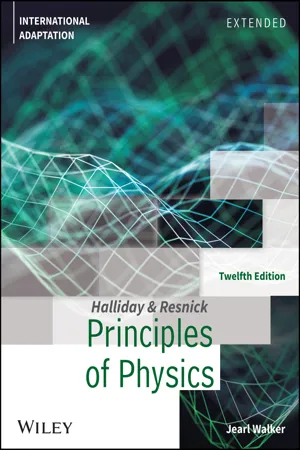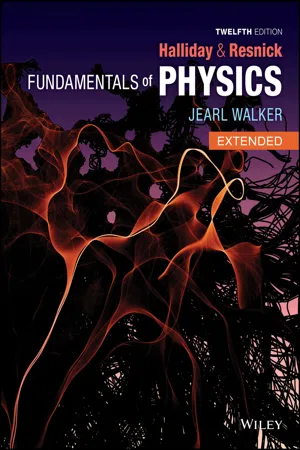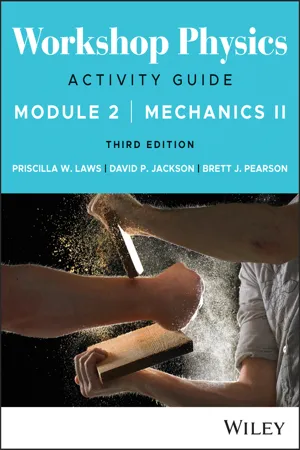Physics
Conservative Forces and Potential Energy
Conservative forces are those that do work on an object in a way that depends only on the initial and final positions, not on the path taken. Potential energy is associated with conservative forces and is the energy stored in an object due to its position or configuration. The change in potential energy is equal to the negative of the work done by the conservative force.
Written by Perlego with AI-assistance
Related key terms
1 of 5
10 Key excerpts on "Conservative Forces and Potential Energy"
- David Halliday, Robert Resnick, Jearl Walker(Authors)
- 2023(Publication Date)
- Wiley(Publisher)
175 C H A P T E R 8 After reading this module, you should be able to . . . 8.1.1 Distinguish a conservative force from a nonconservative force. 8.1.2 For a particle moving between two points, identify that the work done by a conservative force does not depend on which path the particle takes. 8.1.3 Calculate the gravitational potential energy of a particle (or, more properly, a particle–Earth system). 8.1.4 Calculate the elastic potential energy of a block–spring system. 8.1 POTENTIAL ENERGY KEY IDEAS 1. A force is a conservative force if the net work it does on a particle moving around any closed path, from an initial point and then back to that point, is zero. Equivalently, a force is conservative if the net work it does on a particle moving between two points does not depend on the path taken by the par- ticle. The gravitational force and the spring force are conservative forces; the kinetic frictional force is a nonconservative force. 2. Potential energy is energy that is associated with the configuration of a system in which a conservative force acts. When the conservative force does work W on a particle within the system, the change ∆U in the potential energy of the system is ∆U = −W. If the particle moves from point x i to point x f , the change in the potential energy of the system is ΔU = − x t x f F(x) dx . 3. The potential energy associated with a system consisting of Earth and a nearby particle is gravitational potential energy. If the particle moves from height y i to height y f , the change in the gravitational potential energy of the particle–Earth system is ∆U = mg( y f − y i ) = mg ∆y. 4. If the reference point of the particle is set as y i = 0 and the corresponding gravitational potential energy of the system is set as U i = 0, then the gravi- tational potential energy U when the particle is at any height y is U( y) = mgy. 5. Elastic potential energy is the energy associated with the state of compression or extension of an elastic object.- eBook - PDF
- Paul Peter Urone, Roger Hinrichs(Authors)
- 2012(Publication Date)
- Openstax(Publisher)
Plot velocity squared versus the distance traveled by the marble. What is the shape of each plot? If the shape is a straight line, the plot shows that the marble’s kinetic energy at the bottom is proportional to its potential energy at the release point. Figure 7.9 A marble rolls down a ruler, and its speed on the level surface is measured. 7.4 Conservative Forces and Potential Energy Potential Energy and Conservative Forces Work is done by a force, and some forces, such as weight, have special characteristics. A conservative force is one, like the gravitational force, for which work done by or against it depends only on the starting and ending points of a motion and not on the path taken. We can define a potential energy (PE) for any conservative force, just as we did for the gravitational force. For example, when you wind up a toy, an egg timer, or an old-fashioned watch, you do work against its spring and store energy in it. (We treat these springs as ideal, in that we assume there is no friction and no production of thermal energy.) This stored energy is recoverable as work, and it is useful to think of it as potential energy contained in the spring. Indeed, the reason that the spring has this characteristic is that its force is conservative. That is, a conservative force results in stored or potential energy. Gravitational potential energy is one example, as is the energy stored in a spring. We will also see how conservative forces are related to the conservation of energy. Potential Energy and Conservative Forces Potential energy is the energy a system has due to position, shape, or configuration. It is stored energy that is completely recoverable. A conservative force is one for which work done by or against it depends only on the starting and ending points of a motion and not on the path taken. We can define a potential energy (PE) for any conservative force. - eBook - PDF
- David Halliday, Robert Resnick, Jearl Walker(Authors)
- 2021(Publication Date)
- Wiley(Publisher)
186 C H A P T E R 8 Potential Energy and Conservation of Energy 8.1 POTENTIAL ENERGY Learning Objectives After reading this module, you should be able to . . . 8.1.1 Distinguish a conservative force from a noncon- servative force. 8.1.2 For a particle moving between two points, iden- tify that the work done by a conservative force does not depend on which path the particle takes. 8.1.3 Calculate the gravitational potential energy of a particle (or, more properly, a particle–Earth system). 8.1.4 Calculate the elastic potential energy of a block– spring system. Key Ideas ● A force is a conservative force if the net work it does on a particle moving around any closed path, from an initial point and then back to that point, is zero. Equiva- lently, a force is conservative if the net work it does on a particle moving between two points does not depend on the path taken by the particle. The gravitational force and the spring force are conservative forces; the kinetic frictional force is a nonconservative force. ● Potential energy is energy that is associated with the configuration of a system in which a conservative force acts. When the conservative force does work W on a particle within the system, the change ∆U in the poten- tial energy of the system is ∆U = −W. If the particle moves from point x i to point x f , the change in the potential energy of the system is ΔU = − x t x f F(x) dx . ● The potential energy associated with a system con- sisting of Earth and a nearby particle is gravitational potential energy. If the particle moves from height y i to height y f , the change in the gravitational potential energy of the particle–Earth system is ∆U = mg( y f − y i ) = mg ∆y. ● If the reference point of the particle is set as y i = 0 and the corresponding gravitational potential energy of the system is set as U i = 0, then the gravitational potential energy U when the particle is at any height y is U( y) = mgy. - David Halliday, Jearl Walker, Patrick Keleher, Paul Lasky, John Long, Judith Dawes, Julius Orwa, Ajay Mahato, Peter Huf, Warren Stannard, Amanda Edgar, Liam Lyons, Dipesh Bhattarai(Authors)
- 2020(Publication Date)
- Wiley(Publisher)
CHAPTER 8 Potential energy and conservation of energy 8.1 Potential energy LEARNING OBJECTIVES After reading this module, you should be able to: 8.1.1 state the closed‐path test for a conservative force 8.1.2 for a particle moving between two points, identify that the work done by a conservative force does not depend on which path the particle takes 8.1.3 calculate the gravitational potential energy of a particle (or, more properly, a particle–Earth system) 8.1.4 calculate the elastic potential energy of a block–spring system. KEY IDEAS • A force is a conservative force if the net work it does on a particle moving around any closed path, from an initial point and then back to that point, is zero. Equivalently, a force is conservative if the net work it does on a particle moving between two points does not depend on the path taken by the particle. The gravitational force and the spring force are conservative forces; the kinetic frictional force is a nonconservative force. • Potential energy is energy that is associated with the configuration of a system in which a conservative force acts. When the conservative force does work W on a particle within the system, the change ΔU in the potential energy of the system is ΔU = -W. If the particle moves from point x i to point x f , the change in the potential energy of the system is ΔU = - ∫ x f x i F (x) dx. • The potential energy associated with a system consisting of Earth and a nearby particle is gravitational potential energy. If the particle moves from height y i to height y f , the change in the gravitational potential energy of the particle–Earth system is ΔU = mg(y f - y i ) = mgΔy. • If the reference point of the particle is set as y i = 0 and the corresponding gravitational potential energy of the system is set as U i = 0, then the gravitational potential energy U when the particle is at any height y is U (y) = mgy.- eBook - PDF
- David Halliday, Robert Resnick, Jearl Walker(Authors)
- 2020(Publication Date)
- Wiley(Publisher)
150 What Is Physics? One job of physics is to identify the different types of energy in the world, especially those that are of common importance. One general type of energy is potential energy U. Technically, potential energy is energy that can be associated with the configuration (arrangement) of a system of objects that exert forces on one another. C H A P T E R 8 Potential Energy and Conservation of Energy 8-1 POTENTIAL ENERGY Learning Objectives After reading this module, you should be able to . . . ● A force is a conservative force if the net work it does on a particle moving around any closed path, from an initial point and then back to that point, is zero. Equivalently, a force is conservative if the net work it does on a particle moving between two points does not depend on the path taken by the particle. The gravitational force and the spring force are conservative forces; the kinetic frictional force is a nonconservative force. ● Potential energy is energy that is associated with the configuration of a system in which a conservative force acts. When the conservative force does work W on a particle within the system, the change ∆U in the potential energy of the system is ∆U = −W. If the particle moves from point x i to point x f , the change in the potential energy of the system is ΔU = − ∫ x f x i F(x) dx. ● The potential energy associated with a system consist- ing of Earth and a nearby particle is gravitational potential energy. If the particle moves from height y i to height y f , the change in the gravitational potential energy of the particle–Earth system is ∆U = mg( y f − y i ) = mg ∆y. ● If the reference point of the particle is set as y i = 0 and the corresponding gravitational potential energy of the system is set as U i = 0, then the gravitational potential energy U when the particle is at any height y is U( y) = mgy. ● Elastic potential energy is the energy associated with the state of compression or extension of an elastic object. - eBook - PDF
- William Moebs, Samuel J. Ling, Jeff Sanny(Authors)
- 2016(Publication Date)
- Openstax(Publisher)
Potential energy for an ideal spring U(x) = 1 2 kx 2 + const. Work done by conservative force over a closed path W closed path = ∮ E → cons · d r → = 0 Condition for conservative force in two dimensions ⎛ ⎝ dF x dy ⎞ ⎠ = ⎛ ⎝ dF y dx ⎞ ⎠ Conservative force is the negative derivative of potential energy F l = − dU dl Conservation of energy with no non-conservative forces 0 = W nc, AB = Δ(K + U) AB = ΔE AB . SUMMARY 8.1 Potential Energy of a System • For a single-particle system, the difference of potential energy is the opposite of the work done by the forces acting on the particle as it moves from one position to another. • Since only differences of potential energy are physically meaningful, the zero of the potential energy function can be chosen at a convenient location. 386 Chapter 8 | Potential Energy and Conservation of Energy This OpenStax book is available for free at http://cnx.org/content/col12031/1.5 • The potential energies for Earth’s constant gravity, near its surface, and for a Hooke’s law force are linear and quadratic functions of position, respectively. 8.2 Conservative and Non-Conservative Forces • A conservative force is one for which the work done is independent of path. Equivalently, a force is conservative if the work done over any closed path is zero. • A non-conservative force is one for which the work done depends on the path. • For a conservative force, the infinitesimal work is an exact differential. This implies conditions on the derivatives of the force’s components. • The component of a conservative force, in a particular direction, equals the negative of the derivative of the potential energy for that force, with respect to a displacement in that direction. 8.3 Conservation of Energy • A conserved quantity is a physical property that stays constant regardless of the path taken. • A form of the work-energy theorem says that the change in the mechanical energy of a particle equals the work done on it by non-conservative forces. - eBook - PDF
- Robert Resnick, David Halliday, Kenneth S. Krane(Authors)
- 2016(Publication Date)
- Wiley(Publisher)
257 ENERGY 2: POTENTIAL ENERGY I n the last chapter we began our study of energy with an introduction to work and kinetic energy. In this chapter we introduce another kind of energy, potential energy, which is energy that can be stored in a system when certain types of forces act between its compo- nents. Taking into account the kinetic and potential energies of a system, we have the law of conservation of mechanical energy, which provides a way of understanding mechanical problems that is based on Newton’s laws but often provides new or different insights. Based on this conservation law, we can re-analyze a num- ber of problems in translational and rotational motion that we have previously solved with Newton’s laws. The next chapter continues to broaden and expand our concepts of energy into a more general form of en- ergy conservation law. 12-1 CONSERVATIVE FORCES Potential energy is defined only for a certain class of forces called conservative forces. Before we define what we mean by a conservative force, let us consider examples of the be- havior of three different forces: the spring force, F x kx; the gravitational force, F y mg; and the frictional force, f N. Our goal is to examine the work done by each force as a particle acted upon by that force moves along a path and returns to its starting point. 1. The spring force. Figure 12-1 shows a block of mass m attached to a spring of force constant k; the block slides without friction across a horizontal surface. Initially (Fig. 12-1a) an external agent has compressed the spring so that the block is displaced to x d from its position at x 0 when the spring is relaxed. The external agent is suddenly removed at t 0, and the spring begins to do work on the block. As the block moves from x d to x 0, the spring does work (Eq. 11-16). According to the work – energy theorem, this work appears as kinetic energy of the block. - eBook - PDF
- John D. Cutnell, Kenneth W. Johnson, David Young, Shane Stadler(Authors)
- 2018(Publication Date)
- Wiley(Publisher)
Therefore, consistent with version 2 of the definition of a conservative force, W gravity = 0 J for a closed path. The gravitational force is our first example of a conservative force. Later, we will encounter others, such as the elastic force of a spring and the electrical force of electrically charged par- ticles. With each conservative force we will associate a potential energy, as we have already done in the gravitational case (see Equation 6.5). For other conservative forces, however, the algebraic form of the potential energy will differ from that in Equation 6.5. Not all forces are conservative. A force is nonconservative if the work it does on an object moving between two points depends on the path of the motion between the points. The kinetic frictional force is one example of a nonconservative force. When an object slides over a surface and kinetic friction is present, the frictional force points opposite to the sliding motion and does negative work. Between any two points, greater amounts of work are done over longer paths between the points, so that the work depends on the choice of path. Thus, the kinetic frictional force is nonconservative. Air resistance is another nonconservative force. The concept of poten- tial energy is not defined for a nonconservative force. For a closed path, the total work done by a nonconservative force is not zero as it is for a conservative force. In Figure 6.14, for instance, a frictional force would oppose the motion and slow down the car. Unlike gravity, friction would do negative work on the car throughout the entire trip, on both the up and down parts of the motion. Assuming that the car makes it back to the starting point, the car would have less kinetic energy than it had originally. Table 6.2 gives some examples of conservative and nonconservative forces. Start FIGURE 6.14 A roller coaster track is an example of a closed path. - eBook - PDF
Workshop Physics Activity Guide Module 2
Mechanics II
- Priscilla W. Laws, David P. Jackson, Brett J. Pearson(Authors)
- 2023(Publication Date)
- Wiley(Publisher)
In other words, the system’s mechanical energy is conserved. Defining a potential energy function is the first step toward developing the law of conservation of energy. Like the law of conservation of momentum, this principle is extremely powerful and allows us to analyze certain types of prob- lems with minimal effort. 11.2 CONSERVATIVE AND NON-CONSERVATIVE FORCES In the example above, the change in the ball’s kinetic energy is a direct result of the gravitational force between the ball and Earth. Any force that allows the kinetic energy to be temporarily “stored” and then returned in its entirety is called a conservative force. Gravity is an example of a conservative force. Some forces act on objects in such a way that the kinetic energy is not stored, and so mechanical energy is “lost” from the system; such forces are called non-conservative. As the following activity demonstrates, friction is an example of a non-conservative force. You may find it helpful to have a wooden block available while doing the activity. 11.2.1. Activity: Kinetic Energy of a Sliding Block a. Consider placing an object such as a wooden block (m = 0.35 kg) on a tabletop in which the coefficient of sliding friction is k = 0.4. Imagine giving the block a quick push so that it has an initial speed of v = 2.8 m/s. It then slides to a stop (before falling off the end of the table!). We are interested in the motion of the block after you release it. Take the system to be composed of only the block and treat it as a point particle. Draw a free-body diagram showing all the forces acting on the block and explain whether the work done by each force is positive, negative, or zero. b. Use the work-energy principle for a point particle (or, equivalently, the center-of-mass equation) to determine the distance the block slides before coming to rest. Hint: You may wish to review Section 10.7. - eBook - PDF
- John D. Cutnell, Kenneth W. Johnson, David Young, Shane Stadler(Authors)
- 2015(Publication Date)
- Wiley(Publisher)
The kinetic energy increases when the net force does positive work and decreases when the net force does negative work. 6.3 Gravitational Potential Energy Work done by the force of gravity on an object of mass m is given by Equation 6.4, where h 0 and h f are the initial and final heights of the object, respectively. Gravitational potential energy PE is the energy that an object has by virtue of its position. For an object near the surface of the earth, the gravitational potential energy is given by Equation 6.5, where h is the height of the object relative to an arbitrary zero level. 6.4 Conservative Versus Nonconservative Forces A conservative force is one that does the same work in moving an object between two points, independent of the path taken between the points. Al- ternatively, a force is conservative if the work it does in moving an object around any closed path is zero. A force is nonconservative if the work it does on an object moving between two points depends on the path of the motion between the points. 6.5 The Conservation of Mechanical Energy The total mechanical energy E is the sum of the kinetic energy and potential energy: E 5 KE 1 PE. The work–energy theorem can be expressed in an alter- nate form as shown in Equation 6.8, where W nc is the net work done by the external nonconservative forces, and E f and E 0 are the final and initial total mechanical energies, respectively. The principle of conservation of mechanical energy states that the total mechanical energy E remains constant along the path of an object, provided that the net work done by external nonconser- vative forces is zero. Whereas E is constant, KE and PE may be transformed into one another. 6.6 Nonconservative Forces and the Work–Energy Theorem/6.7 Power Average power P is the work done per unit time or the rate at which work is done, as shown in Equation 6.10a. It is also the rate at which energy changes, as shown in Equation 6.10b.
Index pages curate the most relevant extracts from our library of academic textbooks. They’ve been created using an in-house natural language model (NLM), each adding context and meaning to key research topics.









